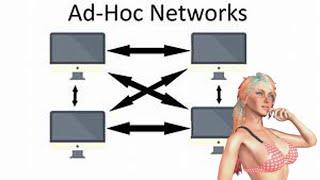
Forwarding procedure principles & parameters
Wireless Ad-Hoc Networks Online Course
https://giladjames.com
Section: Probabilistic Routing in Opportunistic Ad Hoc Networks
Lesson: Forwarding procedure principles & parameters
Wireless Ad-Hoc Networks.
This course is brought to you by Gilad James Mystery School. Learn more at Gilad James.com.
Introduction
Routing packets in multi-hop ad hoc wireless networks poses a great challenge mainly due to the unreliability of the wireless links and the inherent interference of the wireless medium. Due to these characteristics, traditional wired routing schemes that select the best path towards a destination and forward the packet to a specific next hop, have proven ill-suited for networks utilizing the wireless medium and relying on lossy broadcast links. Lately, a new routing paradigm, namely opportunistic routing, has been proposed to cope with unreliable transmissions by taking advantage of the broadcast nature and spatial diversity of the wireless medium .
Opportunistic routing constitutes a new routing paradigm leveraging the nodes' ability to overhear a broadcast packet. Its core difference from traditional routing schemes in that forwarders can be selected from the group of recipients of the packet even after its transmission, hence there is no hard commitment to a predetermined path. This flexibility enables opportunistic routing to combine multiple weak links to create a reliable route, as well as to exploit unexpectedly long transmissions. The added forwarding reliability in transmission reduces the retransmission cost, which in turn improves the throughput and energy efficiency
Proposed opportunistic protocols demonstrate a lack of concrete understanding of the way key wireless networking primitives and design decisions affect the performance of an opportunistic routing scheme. As a result, it is unclear to which extent the improved performance of these protocols owes to their opportunistic design and to which extent it is affected by other design features that can also be applied to traditional routing schemes. Opportunistic protocols which decide on forwarders in a centralized manner require the exchange of node coordination messages, leading to high overhead and increased resource consumption. Furthermore they require global knowledge of the topology which makes them prone to poor performance in the event of misinformation.
On the other hand, localized probabilistic forwarding decision protocols, which have been designed mostly for use in sensor networks, have to trade high performance for robustness and simplicity. In fact some of them partly rely on flooding techniques, thus demonstrating a percolation behavior, which leads to unnecessary transmissions .
In designing of an opportunistic routing scheme, there are two key design decisions. Firstly, how node receiving a packet should decide to forward or not. Secondly, provided that a node has decided to relay a packet, based on some metric, when is the most appropriate time to do so. Here, using a simulation framework, we examine how the forwarding decisions and transmission timing affect performance and under which channel error conditions and topology density it is beneficial to use opportunistic routing instead of traditional routing. Furthermore, we develop an opportunistic forwarding scheme, whose parameters can be tuned to allow for low resource consumption and high delay performance, while being robust to misinformation. We provide evidence which confirms that the suggested protocol supports multiple flows in a network, a weakness of existing early demonstrated solutions in the literature. Finally, to evaluate the scheme, and the role of the wireless primitives in forwarding, we provide comparisons to single-path routing and two opportunistic routing protocols, SOAR and Directed Transmission. Our simulation results, under various channel error and misinformation conditions, demonstrate that the proposed routing protocol outperforms both SOAR which uses a centralized scheme for forwarding decision-making and Directed Transmission which, designed for sensor networks, is distributed using only local information.
Initially, the routing tec
#wireless #ad-hoc #networks
https://giladjames.com
Section: Probabilistic Routing in Opportunistic Ad Hoc Networks
Lesson: Forwarding procedure principles & parameters
Wireless Ad-Hoc Networks.
This course is brought to you by Gilad James Mystery School. Learn more at Gilad James.com.
Introduction
Routing packets in multi-hop ad hoc wireless networks poses a great challenge mainly due to the unreliability of the wireless links and the inherent interference of the wireless medium. Due to these characteristics, traditional wired routing schemes that select the best path towards a destination and forward the packet to a specific next hop, have proven ill-suited for networks utilizing the wireless medium and relying on lossy broadcast links. Lately, a new routing paradigm, namely opportunistic routing, has been proposed to cope with unreliable transmissions by taking advantage of the broadcast nature and spatial diversity of the wireless medium .
Opportunistic routing constitutes a new routing paradigm leveraging the nodes' ability to overhear a broadcast packet. Its core difference from traditional routing schemes in that forwarders can be selected from the group of recipients of the packet even after its transmission, hence there is no hard commitment to a predetermined path. This flexibility enables opportunistic routing to combine multiple weak links to create a reliable route, as well as to exploit unexpectedly long transmissions. The added forwarding reliability in transmission reduces the retransmission cost, which in turn improves the throughput and energy efficiency
Proposed opportunistic protocols demonstrate a lack of concrete understanding of the way key wireless networking primitives and design decisions affect the performance of an opportunistic routing scheme. As a result, it is unclear to which extent the improved performance of these protocols owes to their opportunistic design and to which extent it is affected by other design features that can also be applied to traditional routing schemes. Opportunistic protocols which decide on forwarders in a centralized manner require the exchange of node coordination messages, leading to high overhead and increased resource consumption. Furthermore they require global knowledge of the topology which makes them prone to poor performance in the event of misinformation.
On the other hand, localized probabilistic forwarding decision protocols, which have been designed mostly for use in sensor networks, have to trade high performance for robustness and simplicity. In fact some of them partly rely on flooding techniques, thus demonstrating a percolation behavior, which leads to unnecessary transmissions .
In designing of an opportunistic routing scheme, there are two key design decisions. Firstly, how node receiving a packet should decide to forward or not. Secondly, provided that a node has decided to relay a packet, based on some metric, when is the most appropriate time to do so. Here, using a simulation framework, we examine how the forwarding decisions and transmission timing affect performance and under which channel error conditions and topology density it is beneficial to use opportunistic routing instead of traditional routing. Furthermore, we develop an opportunistic forwarding scheme, whose parameters can be tuned to allow for low resource consumption and high delay performance, while being robust to misinformation. We provide evidence which confirms that the suggested protocol supports multiple flows in a network, a weakness of existing early demonstrated solutions in the literature. Finally, to evaluate the scheme, and the role of the wireless primitives in forwarding, we provide comparisons to single-path routing and two opportunistic routing protocols, SOAR and Directed Transmission. Our simulation results, under various channel error and misinformation conditions, demonstrate that the proposed routing protocol outperforms both SOAR which uses a centralized scheme for forwarding decision-making and Directed Transmission which, designed for sensor networks, is distributed using only local information.
Initially, the routing tec
#wireless #ad-hoc #networks
Комментарии:
Forwarding procedure principles & parameters
Gilad James Mystery School
How to Paint Mechanicum in Red for Warhammer: The Horus Heresy
Medders' Miniatures
Mr M & Revelation - Worship Altar (Ancient Songs)
Mr M & Revelation official
Painting Mechanicum Archmagos for Warhammer: The Horus Heresy
Medders' Miniatures
Mr M And Revelation || March Edition || Breakthrough Encounter 2022
Rccg Champions Cathedral
Монитор переносит детей Оливера в прошлое | Стрела
BeST MoMeNTS v2.0
The Christmas Masterpiece | An Inspiring Holiday Movie | Free Full Film
Studio Dome's YouTube Channel
Best tabla performance
Gulbarga News Network


























